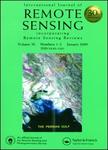版权所有:内蒙古大学图书馆 技术提供:维普资讯• 智图
内蒙古自治区呼和浩特市赛罕区大学西街235号 邮编: 010021

作者机构:China Univ Min & Technol Beijing Coll Geosci & Surveying Engn Beijing Peoples R China China Univ Min & Technol Beijing Coll Geosci & Surveying Engn Ding 11 Xueyuan Rd Beijing 100083 Peoples R China
出 版 物:《INTERNATIONAL JOURNAL OF REMOTE SENSING》 (国际遥感杂志)
年 卷 期:2023年第44卷第21期
页 面:6825-6844页
核心收录:
学科分类:083002[工学-环境工程] 0830[工学-环境科学与工程(可授工学、理学、农学学位)] 1002[医学-临床医学] 08[工学] 09[农学] 0804[工学-仪器科学与技术] 0903[农学-农业资源与环境] 0816[工学-测绘科学与技术] 081602[工学-摄影测量与遥感] 081102[工学-检测技术与自动化装置] 0811[工学-控制科学与工程]
基 金:National Natural Science Foundation of China [42271389 41571412]
主 题:Natural gas micro-leakage hyperspectral temporal feature feature selection
摘 要:Timely detection of underground natural gas leakage is significant for the safe production of gas storage and the protection of ecological environment. Direct detection makes it difficult to identify natural gas micro-leakage accurately, while hyperspectral remote sensing can identify micro-leakage based on spectral changes of vegetation near the leakage area. However, the spectral morphological characteristics of vegetation leaves under natural gas micro-leakage will undergo complex changes over time, making it difficult to identify vegetation stress. Temporal spectral characteristics improve the capability of capturing spectral differences of stressed vegetation at different times, allowing for indirect evaluation of leaked information. This study simulates the stress of underground natural gas storage micro leaks on bean growth through field experiments. Based on the changes in spectral reflectance and chlorophyll content of leaves, temporal features were constructed based on multi-temporal reflectance data, and feature selection methods were used to obtain bands sensitive to natural gas stress. This paper proposed a leaf scale natural gas micro-leakage identification index based on temporal spectral features (TNII) to identify bean stress under natural gas leakage. The results are summarized as follows: (1) With the leakage of underground natural gas, the spectral reflectance of leaves increased in the visible and near-infrared range, and the chlorophyll content decreased. (2) The TNII (R-676-R-526)(Tn)-(R-676-R-526)(T1)/(R-676-R-526)(Tn)+(R-676-R-526)(T1) constructed based on sensitive wavebands (676 and 526 nm) can be employed to identify bean stress under natural gas after 17 days of leakage. The JM (Jefferies Matusita) distance test indicates that TNII could timely and stably identify bean stress under natural gas micro-leakage (JM 1.8). This study provides the theoretical basis and technology support for micro-leakage detection of underground gas storage